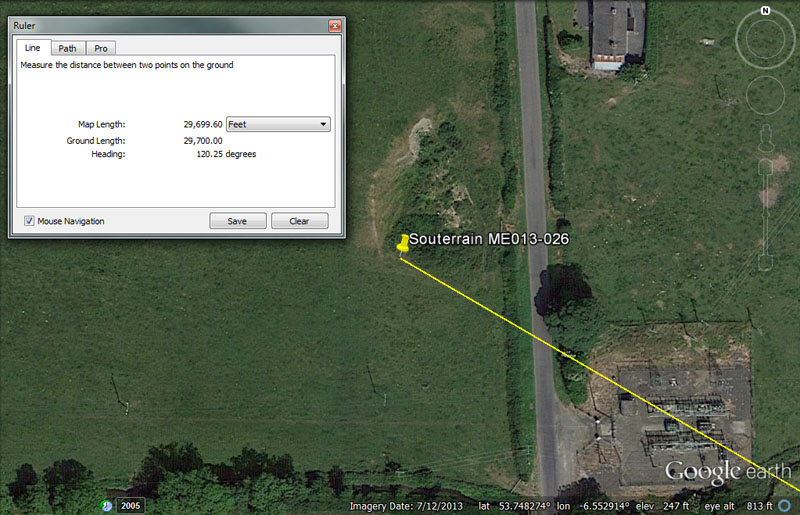
THOSE MORE DISTANT SITES, SITUATED MANY MILES FROM THE BOYNE RIVER VALLEY.
It seems likely that outlier, artificial island sites constructed beyond a certain distance from the Boyne River Valley would have used two primary fulcrum positions (for triangulation) within the valley as the hubs from which orienteers ventured out on a coded distance and angle vector to find the assigned objective.
This is because a very small discrepancy in a code-bearing degree angle to sites close to Knowth, Newgrange or Dowth chambered mounds or Dowth Henge, could fan-out to be a very large discrepancy on sites distributed many miles from the main centres.
Under such circumstances, a mere 1/5th of a degree of error could culminated in missing the distant objective by many hundreds of yards.
It seems plausible to assume, therefore, that semi-hidden structures like the all-important souterrain accommodation facilities, especially, which would have been difficult to find even under ideal conditions, required extra-accurate vectors to plot their positions.
Nearer to the 4 main centres, the flaring degree angles weren't a problem and each objective could be found by religiously adhering to the special parcel of navigational numbers only. However, further out, degree angles might need to be padded, rounded or modified very slightly, although distances of placement for an outlier structure could still fall comfortably within the code-bearing parameters.
Let's look at some hard-to-find, distant souterrains that might fall into this category:

Before navigating to assigned structures
in the vicinity of Mountfortescue, the ancient orienteers might have needed
to find this souterrain hostel at Grangegeeth by dusk on the previous day,
to ensure a good night's sleep and sustenance out of the wind and rain.
The souterrain stands 29700' from the centre of Dowth Henge at an angle back
to the henge of 120.25-degrees.
The distance is 5 Scottish miles of 5940' each or 5& 5/8ths English miles. Note: the ancient Scottish mile was 1 furlong/furrowlong (660') greater than the English mile.
Although the angle of 120.25-degrees is not a coded number, 120-degrees (1/3rd of 360-degrees) is and the souterrain would be very findable on that close-proximity vector.
KILBREW & IRISHTOWN
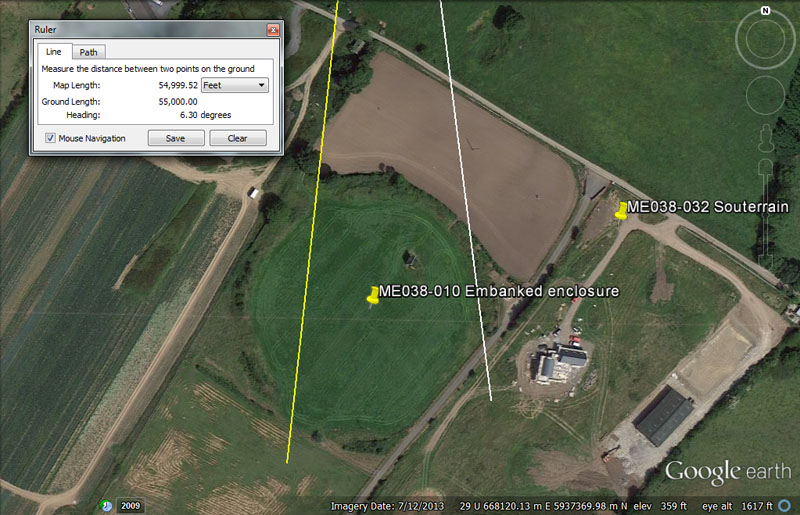
This huge embanked enclosure sits 52800' (10-miles) from Knowth @ 172.8-degrees. From Dowth Henge it is 55000' @ 6-degrees return. This site is officially 128 metres in diameter. This equates to an intended diameter of 420', converting to a circumference of 1320' using PI @ 22/7ths.
Obviously, this large embanked enclosure was a very important training centre and a lot of work was expended to build it. Triangulations from each end of the Dowth Henge to Knowth chambered mound, surveyor's baseline determined that its coded or purpose-placed position would be 3 & 1/3rd leagues from Dowth Henge and 10-miles from Knowth chambered mound.
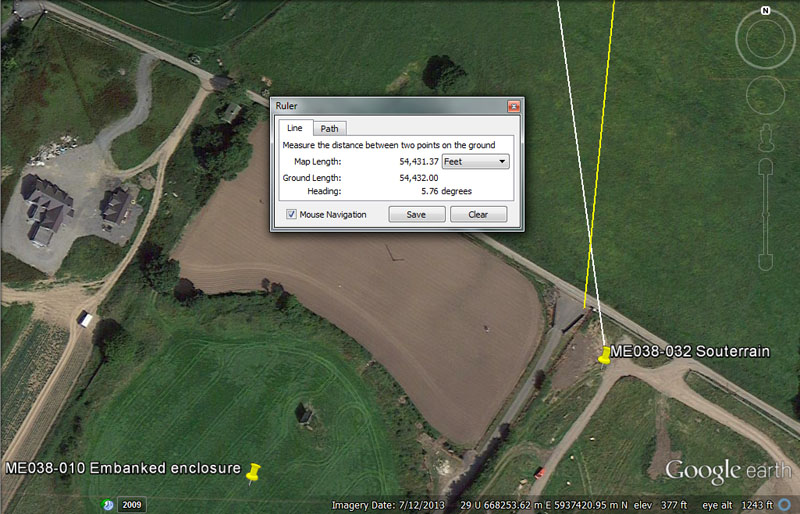
The all-important souterrain accommodation sat adjacent to the huge enclosure and it's probable that a community resided here to maintain the embankments, grounds, as well as nearby structures or offered tutorials to transient students. The embankments, undoubtedly, worked as an artificial-horizon for training students in astronomy and use of the celestial map, with stars ascending from or alighting onto the embankments.
Although students arriving at the site were probably directed to their living quarters by the permanent residents, the location of the souterrain complex could be calculated by triangulation from the Dowth Henge - Knowth chambered mound surveyor's baseline.
The distance to the souterrain complex from Knowth is 52500' @ 172.5-degrees. The distance from Dowth is 54432' @ 5.76-degrees return. Each of these values is code-bearing except 172.5, which is without meaing, but would be highly significant at 172.8-degrees.
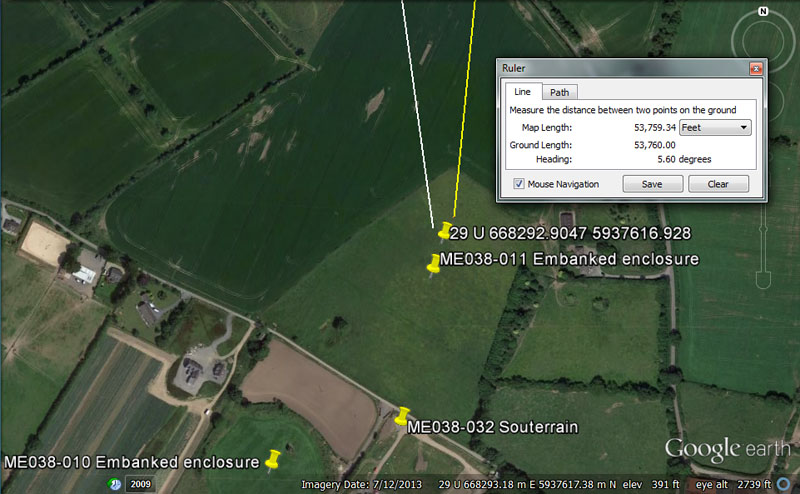
Situated slightly NNE of the giant embanked enclosure was yet another enclosure, attesting to the fact that the Kilbrew-Irishtown complex was an important ancient centre of activity.
Although it cannot be visually detected on Google Earth, the secondary embanked enclosure sits at the coordinates shown. The intended coded distance and angle from Knowth is 51840' @ 172.8-degrees. From Dowth it is 53760' removed at @ 5.6-degrees return.
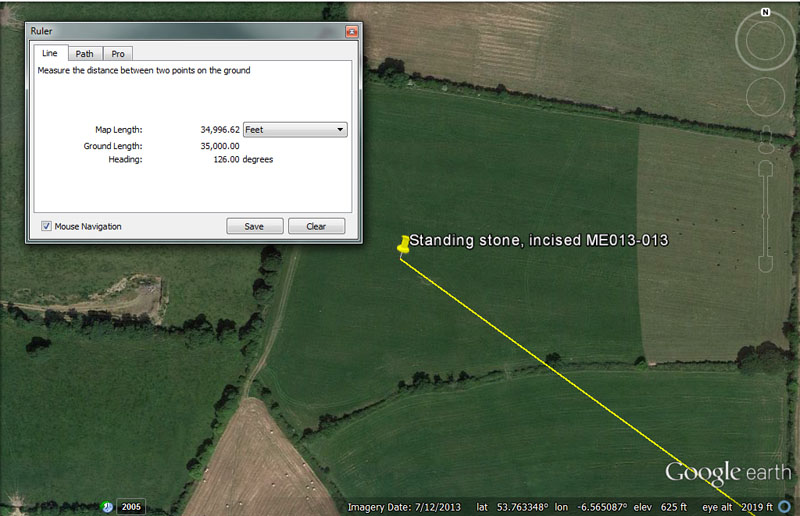
And while the ancient orienteers were wending their way, from structure-to-structure towards Mountfortescue, some would have been assigned to find and describe the markings on this incised standing stone nearby. It sits 35000 feet from the centre of Dowth Henge at a return angle of 126-degrees.
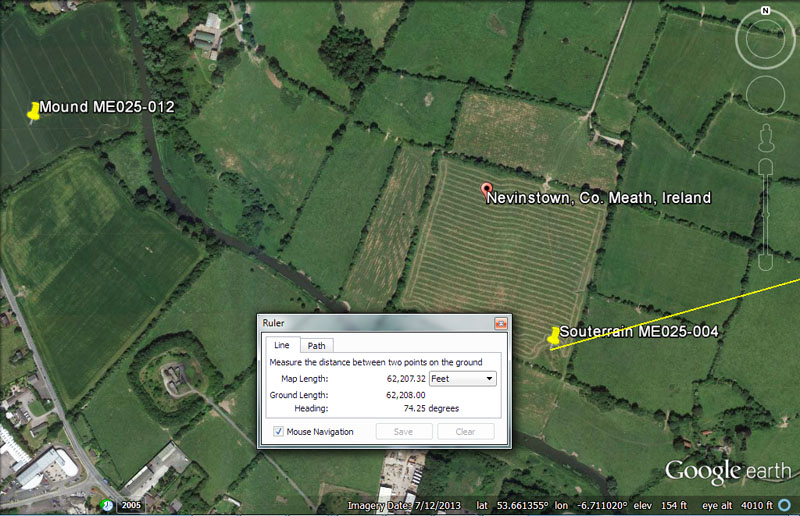
Similarly, if the ancient orienteers had been assigned to find the mound at modern day Nevinstown, they'd also need to locate their accommodation for the night in the nearby souterrain dormitory in this field.
Their orienteering map, issued by the Master of the Craft tutors at Dowth henge, would indicate that the souterrain accommodation sat 62208' feet distant at an azimuth angle of 254.25-degrees (for a return angle back to the henge of 74.25-degrees).
With the Earth's equatorial circumference set at 24883.2-miles, the sum of 6220.8-miles = 1/4th of 24883.2-miles.
Likewise, the distance of 62208' equates to 1/2100th of the equatorial circumference or 10 & 2/7ths minutes of equatorial arc.
The degree angle is navigational and a length of 742.5' would be 1/8th of the 5940' Scottish mile.